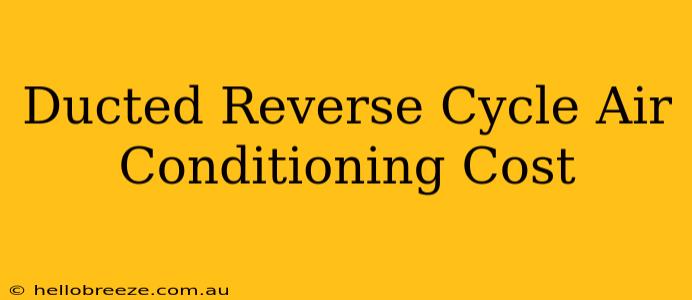Thinking about installing ducted reverse cycle air conditioning? It's a significant investment, so understanding the cost is crucial. This guide breaks down the factors influencing the price of ducted reverse cycle AC, helping you budget effectively.
Factors Affecting Ducted Reverse Cycle Air Conditioning Costs
Several factors contribute to the overall cost of installing a ducted reverse cycle air conditioning system. Let's explore them in detail:
1. System Size and Capacity:
This is arguably the biggest factor. Larger homes require larger systems with more powerful capacity (measured in kilowatts or kW). A larger system naturally costs more than a smaller one. Accurate assessment of your home's size and insulation is essential for determining the right system capacity. Undersizing will lead to inefficient cooling and heating, while oversizing is wasteful and more expensive upfront.
2. Type of System:
Different brands and models offer varying features and technologies. Inverter systems, for example, are generally more energy-efficient and often more expensive upfront but can save you money in the long run through reduced energy bills. Consider the features you need - things like zoning (controlling temperature in different areas of your home), Wi-Fi connectivity, and smart home integration will impact the price.
3. Installation Complexity:
The complexity of the installation significantly affects the cost. Factors include:
- Home size and layout: A multi-story home or a home with complex ductwork layouts will require more labor, increasing the installation cost.
- Existing ductwork: If you have existing ductwork that can be reused, you might save on costs. However, if extensive modifications or new ductwork are necessary, the price will increase.
- Accessibility: Difficult-to-reach areas or obstacles can add to the installation time and cost.
4. Location and Installer:
Your location can impact pricing, with some areas having higher labor costs than others. It's crucial to compare quotes from multiple reputable installers. Be wary of extremely low quotes, as these may compromise quality or workmanship. Ask about warranties and guarantees.
5. Additional Features:
Optional extras, such as zoning systems, smart thermostats, and advanced air filtration systems, add to the overall cost. Evaluate your needs carefully to avoid unnecessary expenses.
Estimating the Cost of Ducted Reverse Cycle Air Conditioning
While it's difficult to give a precise figure without a detailed assessment of your home, you can expect a broad range. The cost can vary greatly depending on the factors mentioned above.
For a typical-sized home (approximately 150-200 square meters), you could expect to pay anywhere from $5,000 to $15,000 or more. Smaller homes will likely fall at the lower end of this range, while larger or more complex installations could exceed the higher end.
Always get multiple quotes from qualified installers to ensure you are getting a competitive price for a high-quality system and installation. Remember, choosing a reputable installer is just as important as choosing the right system.
Making Informed Decisions
Investing in ducted reverse cycle air conditioning is a long-term decision. By understanding the factors influencing the cost and getting multiple quotes, you can make an informed choice that meets your budget and needs. Don’t hesitate to ask installers detailed questions about their pricing breakdown, the equipment they use, and their installation process. This will empower you to choose a system and installer that provides both excellent performance and value for money.

